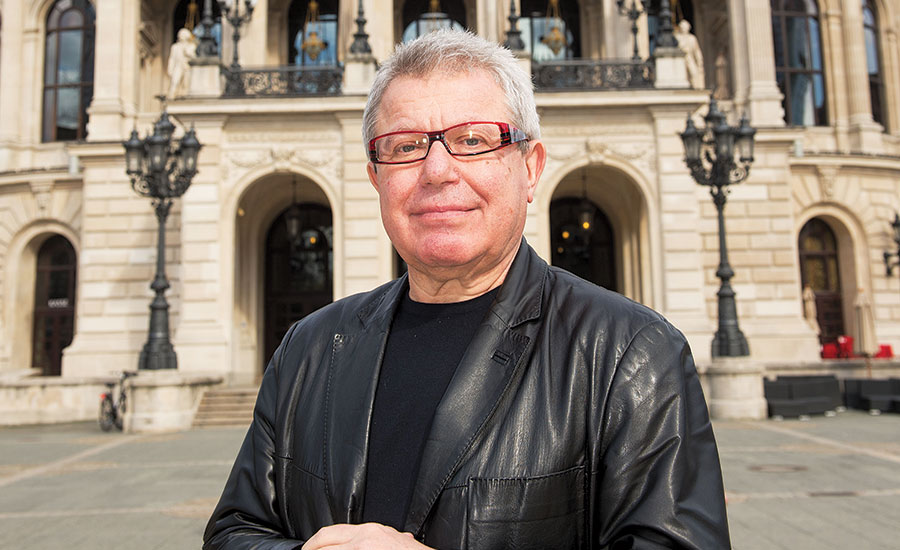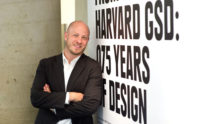Newsmaker: Daniel Libeskind

Photography © AOF, Wonge Bergmann
Before Daniel Libeskind was known as the architect of the Jewish Museum in Berlin and the master planner for the World Trade Center site, he was considered a musical prodigy. His instrument? The accordion. Growing up in Communist Poland, the young Libeskind had to painstakingly transcribe songs from the classical canon (Bach, mostly) to sate his musical appetite, establishing himself as a virtuoso and winning competitions. In 1953, at the age of 7, he performed “Flight of the Bumblebee” on Polish television.
The architect is flexing his musical muscles again, curating a 24-hour cycle of performances with Frankfurt’s Alter Oper on May 21. Called One Day in Life, Libeskind has personally curated more than 75 of the consecutive musical performances that will take place in 18 venues across the city.
The event’s locations are themed according to “dimensions of existence” and include a tram (themed as “Movement”), Oskar Schindler’s apartment (“Secret”), a 51,500-seat arena (“Will”), and an operating room (“Body”). Each concert will be staged multiple times through the day. Libeskind, who has also just launched a new line of seating for Italian furniture maker Moroso spoke with record over the phone from his home in New York.
Architectural Record: How did the idea for One Day in Life come about?
Daniel Libeskind: I was lecturing in Heidelberg and talked about architecture and a bit about music. After my talk, Dr. Stephan Pauly, the head of Alte Oper, said, “Mr. Libeskind, what could you do in Frankfurt?” I thought about it, and wanted to rediscover Frankfurt in a very particular way, creating a labyrinth through the city where music is played in unexpected places, like a hospital or a railway station. The director said, “Wow, what an amazing idea. We will try to make this happen, but we don’t know how.” Lo and behold, it’s coming to life in May!
Is this the first time you have ever done anything like this?
Absolutely! I don’t think it’s just my first time—I don’t know of a systematic exploration of a city with a particular connection between architecture and music.
How did you choose these crazy venues?
They are not crazy, they are very calculated. Nothing is arbitrary here.
I don’t think I have ever been to a concert in a hospital operating room.
One of my favorite composers is Marin Marais, who created a fantastic composition about a gallbladder surgery. I thought it shouldn’t be heard in a concert hall but in a surgical room, where that pain and experience can come alive in the music, and the music can be a device to unlock architecture.
Are the compositions you selected personal favorites?
It was personal. I didn’t go on the internet, believe me; I didn’t go to my collection of CDs at home. I wanted to couple contemporary and classical music, because you can go from the year 1000 AD to the year 2016 within a few minutes of performance in a space that connects them.
Did acoustics factor into your scheme?
Of course, because music should be acoustically fantastic. But it’s not only about acoustics: You can hear a piece of music through a crack of a door, and it might be more powerful for you than music you hear at Lincoln Center.
Can you give us a taste of what some of the music and architectural pairings will be?
Oh my God, there are so many of them.
What are your favorites?
One of my favorites is in a boxing arena. I have programmed a transcription of Beethoven’s entire Fifth Symphony for a solo pianist. A single instrument—just as a boxer has to put his entire vision of life into his hands to knock out his opponent. You will feel it when you are sitting next to the ring. Also, the composer Peter Ablinger took the voices of famous people—Bertolt Brecht, Gertrude Stein, Marcel Duchamp—and transcribed them into music. How appropriate to listen to that in the archives of the national library where every book that has ever been printed in Germany is stored. So that’s the kind of exercise of madness that will bring this music into something tangible and something enjoyable. That’s what music is, and what architecture is.

